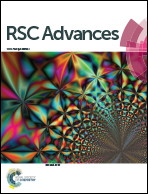Superparamagnetic iron oxide nanoparticles dispersed in Pluronic F127 hydrogel: potential uses in topical applications
Abstract
The present study is focused on the synthesis and characterization of nitric oxide (NO)-releasing superparamagnetic iron oxide nanoparticles (Fe3O4 NPs), and their incorporation in Pluronic F127 hydrogel with great potential for topical applications. Magnetite nanoparticles (Fe3O4 NPs) were synthesized by thermal decomposition of acetylacetonate iron (Fe(acac)3), and coated with the thiol containing molecule mercaptosuccinic acid (MSA), leading to Fe3O4-MSA NPs. The obtained NPs were characterized using different techniques. The results showed that the Fe3O4-MSA NPs have a mean diameter of 11 nm, in the solid state, and superparamagnetic behavior at room temperature. Fe3O4-MSA NPs have an average hydrodynamic size of (78.0 ± 0.9) nm, average size distribution (PDI) of 0.302 ± 0.04, and zeta potential of (−22.10 ± 0.55) mV. Free thiol groups on the Fe3O4-MSA NP surface were nitrosated by the addition of sodium nitrite, yielding S-nitrosated magnetic nanoparticles (Fe3O4-S-nitroso-MSA NPs), which act as spontaneous NO donors upon S–N bond cleavage. The amount of (86.4 ± 4.7) μmol of NO was released per gram of Fe3O4-S-nitroso-MSA NPs. In order to enhance NP dispersion, Fe3O4-MSA NPs were incorporated in Pluronic F127 hydrogel (3.4% w/w), and characterized using different techniques. Rheological measurements suggest a potential use for Fe3O4-MSA NPs dispersed in Pluronic hydrogel for topical applications. Atomic force microscopy (AFM) showed that the NPs are embedded within the Pluronic film while the X-ray photoelectron spectroscopy (XPS) spectrum of the Fe3O4-MSA NPs samples revealed the presence of iron, oxygen, carbon and sulfur, confirming the presence of MSA molecules on the NP surface.



 Please wait while we load your content...
Please wait while we load your content...